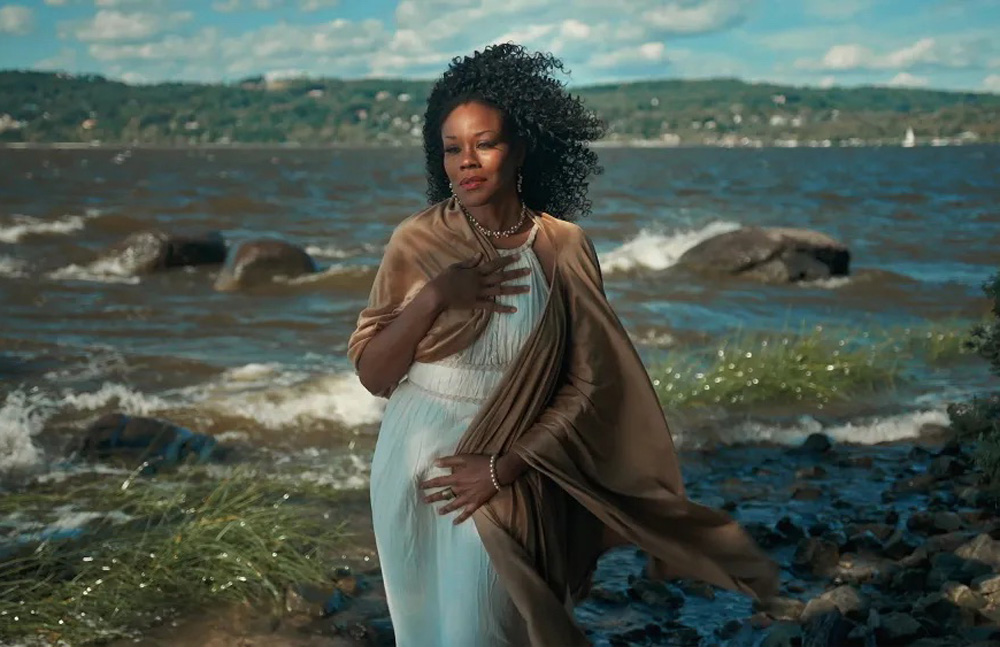“If you look under a microscope at one-day old larvae, you can pretty much hook anybody,” says a scientist in “Holding Back the Tide,” a film which finds the oyster to be an object of endless intrigue. A longtime source of sustenance along the shoreline of New York in both a nutritional and financial sense, director Emily Packer knew the humble mollusk was worthy of a close-up when beyond its value to the ecosystem of the ocean, it held plenty above ground as well when fortunes had been built on the sea creatures, which once were a dime a dozen and now fetch the price of a luxury good. The item itself hadn’t changed, but the value of it radically evolved over time because someone — in this case, a Black restauranteur named Thomas Downing – made it the cornerstone of fine dining in the financial district.
“Holding Back the Tide” not only makes one appreciate the economic impact the oyster could have, but Packer makes that only one part of a broader reconsideration of our entire society spurred on by looking inside the shell when seizing upon the oyster’s biological ability to acclimate to the needs of their ocean, swapping genders depending on what’s going on in the water. Packer considers a world in which such labels weren’t necessary and leads by example when formally the film has the initial thrust of a more traditional documentary, but begins to incorporate more fantastical elements from poetry to mermaids that pop up alongside oyster beds out in the water that imagine how much more exciting the world could be without outdated societal constructs. From the sea to the land, Packer explores how oysters can transform the environments around them with the passion they elicit, from those that farm them and shuck them to entire communities that have ingested them for years and now see them as a model for adaptability when facing a whole variety of concerns.
This isn’t the first time that Packer has tested the waters to thrilling effect, previously teaming with Lesley Steele on the short “By Way of Canarsie” in the wake of Hurricane Sandy to see the ruins left as a chance to rebuild towards a more equitable future from the perspective of Brooklyn locals whose individual efforts contribute to something greater than themselves and the power of collaboration can be felt in “Holding Back the Tide” as well when the director isn’t just actively encouraging it from participants, but ties disparate elements and people together to reveal connections that might not be evident without a collective view. After a celebrated festival run, the film is now headed west from its theatrical tour of the east coast, arriving this week in Los Angeles where Packer will be holding court for a number of Q & As and the director kindly took some time to answer some questions here about how the project came together, showing people in all their dimension in the film and the rewards of daring to push the envelope.
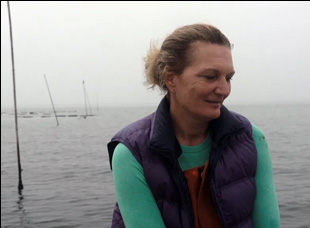
Lesley [Steele], my co-director [on “By Way of Canarsie”] and I were really interested in trying to understand the underlying community desires in Canarsie, even if they were at odds, so we were really approaching the subject by trying to incorporate many, many different lenses. It feels like a precursor to this film because we were trying to take a wide stance in a small place and in “Holding Back the Tide,” I zoomed out and used the oysters almost as like a radio frequency to tune into, but really trying to imagine New York City at large, so it was great to start with something similarly place-based and complex, but with a much smaller footprint before diving into a whole city.
Then Lesley and I were really interested in transit and what the city itself as an institution was willing to put resources into, so we were looking at transit. It was around that time, especially since we were dealing with the water and how [public planning] would affect the natural ecosystem that I learned about the Billion Oyster Project. Just the scale of that endeavor was really interesting to me, especially while thinking in contrast about the city itself and what the city was willing to invest in long-term resilience projects, watching all these both literal and also financial materials being poured into the subway system, the underbelly, for short-term gain whereas the Billion Oyster Project is really forward thinking and interested in huge scale renovation, thinking about a future that we can’t necessarily imagine. Those were two things that drew “Holding Back the Tide” really out of “By Way of Canarsie.”
A beautiful idea in this is the idea of reclaiming public space – you’ll have for instance a gourmet oyster shucker applying their trade throughout the city in urban environments like outside a subway stop. Was that a foundational concept for this?
Yeah, actually the scenes that you’re picking up on were pretty much the first thing that we shot in early March 2020 and then production totally got shut down because of COVID, but we had managed to get that and use it as a starting point for the rest of the film. Myself and my creative team just started wrapping our heads around the historical depictions of oysters and trying to understand the biological queerness of oysters as a way to recalibrate our connotations of the oyster, so we layered all of those ideas on top of each other and Hannah [Rego] was a professional oyster shucker for a time. They’re also a poet, so we consulted with them on some of the poetry for the film.
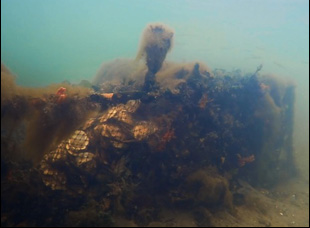
It was definitely more of the latter. Originally, I had pitched this idea as a short film that was mostly centered around the environment, but if I really care about something, I want to look at it prismatically to try to understand all of its intersections. Also because of the pandemic, we just had a lot more time to research than we would have originally imagined for ourselves. The deeper you get into it, [you find] people that love oysters really love them and there’s so much to say about them. There’s things that we couldn’t even cover in this film and trying to decide what was a part of the film and what were paths that we weren’t going to wander down was interesting. We had some exploratory shooting, and had around 100 shoot days, so we really got a chance to explore the archives with oysters, but also really do our own on the ground research to try to figure out what we cared about.
The hybridity [of the project] came about partially because there were things that we really cared about upon doing that research and figuring out our perspective that we couldn’t necessarily go over [using documentary footage alone] and that was a huge creative decision that I had made. We wanted to make experts out of the people who work with the oysters every day and we wanted to go to where knowledge is being disseminated in real life, in real time in the city. We didn’t want an interview with a talking head necessarily, unless we really believe that we can get something from that. We wanted instead to feel like we’re learning through walking through the city and there were some things that we had been informed and solidified some ideas about that we couldn’t overhear. That’s where the poetry and the hybridity came in is [considering] how do we explain these perspectives and integrate those in a way that feels like authentic to our voice.
That might’ve been it, but was there a direction this took that you might not have expected?
What I really love about it that I think of the film like a map of the city in a way, but the transitions are really special. We watched the movie “Tampopo” a few times during production, just thinking about how do we create a city symphony where it really feels like these characters that are concerned with really different aspects of the oyster feel like they’re a part of the same story. I’m particularly proud of having some of our actors bleeding into the more verite documentary style scenes in a way that felt really genuine to place one of those characters in real life in the city. It did something for the character in the story, but it also was mirrored in real life.
For example, the actor Aasia Taylor-Patterson came with us to the Canarsie Pier scene, which was really special to be able to return to. I had interviewed Lucina [Clarke], the main person speaking at the Canarsie Vigil, for “By Way of Canarsie” and it just didn’t totally fit in, but I really liked her and her interest in her own community and I knew she did this vigil every year, so being able to return and then bring the actor who had never been there before to really participate in the culture, she got something out of it — a new perspective on her own belonging in New York and what she wanted to be doing in terms of like community involvement — so that was really special.
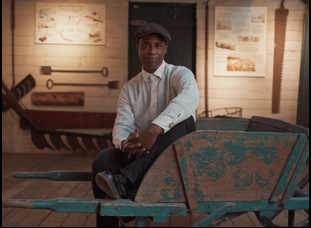
We were really interested in casting with the research in mind, both in the documentary and in the scripted elements of the project, so we definitely wanted to be working with a lot of queer and trans people and to privilege and uplift entrepreneurs of color, and queer and female entrepreneurs. We were also specifically looking to collaborate with people who had active artistic practices outside of acting that were in relation to what we were interested in. So when we met Meghan Dolbey, [who plays] a minor character, her e-mail signature said something like “artist activist.” I really loved how intertwined those things were for her and how interested she was in telling new queer stories, and then Dragonfly [Robin LaVerne Wilson], who was at the Q & A at DocNYC, we met her because she was involved with the eco-sexual movement, but she also has done a lot of political projects and run for mayor. So we wanted to be working with people who could bring a lot to their role and also would feel comfortable lending their own ideas and being more of an active collaborator with us rather than just playing a part.
The actual rhythm of the film is quite propulsive. When did you start feeling it was right?
I would want to shout to the sound design and the music. We were really lucky to be able to collaborate with the artists that we have on the soundtrack. We had a loose relationship with Arooj Aftab before she won a Grammy, and then it became quite difficult to solidify this project. [laughs] But I don’t think anyone, even after she won a Grammy, was that interested in her early work [which] was just so beautiful and really oceanic to me and really called to that [idea of being] above and below the waterline. Similar to the casting, we really wanted to be working with a lot of queer and women artists and a lot of artists of color. Some of that happened very organically where there’s a scene at the fish market where you hear some violin and that violin actually feels nearly diegetic because that violinist was playing on the street there, not actually during the day [of the shoot], but I had been scoping him out while I was prepping for the shoot and really wanted to integrate him into the soundscape and having such an ambient-leaning score helped to give that breath and feeling to what we were doing, even if we were looking at scenes that take place in totally different environments sometimes.
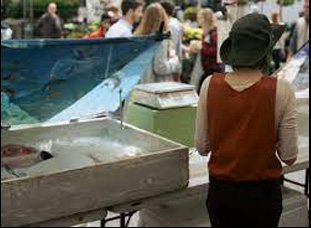
We really believed in this project, and everyone that heard about it while we were making it was excited by it, but there was a strong sense of doubt that it was going to play well in theater spaces because of how multiplicitous it is and how used to character doc we are in American cinema. So getting to show it to audiences and watching them have an emotional experience with this type of filmmaking that’s sitting somewhere between traditional and more experimental work, it really feels like a proof of concept that’s challenging the form and succeeding. That people are engaged with it is incredibly validating and have questions about it and they’re emotionally affected. That was something that we didn’t necessarily expect. We thought we were putting together almost like a thesis with some emotionality, but now we know that it plays like a movie and that it can show in theaters and that people are responding to it as a work of cinema.
“Holding Back the Tide” will screen in Los Angeles on October 2nd at the Monica Film Center, October 3rd at the NoHo 7 and open at the Laemmle Royal from October 4th through 10th. It will continue to play around the U.S. and a full list of theaters and dates is here.




